Sponsored by
We are currently seeking a sponsor for this website
as it follows the progress of the excavations on the battlefield, with contributions from established historians and well known experts, as the team attempt to match the historical evidence and family history to the archaeology on the ground.
If you enjoy this website
please consider making a donation towards the costs of the project.

|
Bolstering the Defence Monday, March 26th, 2018
|
|
|
|
|
The units of 9th Infantry Brigade, 3rd Australian Division began their train journey south, leaving behind the familiar mud of Flanders and the ground they had taken in the Messines Offensive in June 1917. The rest of their Division and the men of 2nd Australian Division were also making a similar journey, heading for the ever retreating front lines as the German Spring offensive continued to drive the Allies back. The trenches and defences in front of Plugstreet Wood and Houplines would soon be occupied by the exhausted and much depleted 25th Division.
100 years ago today 25th Division were relieved from the Old British front line on the Somme, the point from which the big push of July 1916 had been launched. They had been in action for four days, fighting desperately as the German Army has driven them back from the Hindenburg Line across the old battlefields, a distance of more than twenty miles.
On the training grounds of Britain, huge numbers of 18 and 19 year olds, some of whom had not fully completed their courses, were hurriedly equipped and sent on their way to the channel ports. Meanwhile the casualty lists began to be published, list upon list of names of those, killed, captured or missing.
|
|
|
|
|
|
Filed under: Archaeology, Great War History by
PlugStreetTeam
Add a Comment »
|
|
The Spring Offensive Wednesday, March 21st, 2018
|
|
|
|
|
On the morning of the 21st of March 1918 Operation Michael, the Spring Offensive was launched with a huge barrage of artillery on a front which ran from Arras in the north to a distance south of the River Somme. Over the winter the German Army had been building up both men and resources, although the attack was expected, the magnitude was not. Over the next few weeks the Allied forces would be pushed back over hard fought ground.
Whilst the area we have been researching remained quiet, the storm was on the horizon. As the battle raged to the south, in our area around Plogsteert and Houplines, the men of 3rd Australian Division worked hard to complete new defence works and strengthen the existing. In front of Messines and Whitesheets their fellow countrymen took on similar tasks, to the south and west of Armentieres where the ground was flat and wet, British troops filled sandbags to patch the breastwork and dug into sodden earth. Behind them others, assisted by the Australians fortified the 2nd GHQ Line and the forts and posts beyond.
This winter our team have been researching the defensive works and the change of tactics on the Western Front as well as continuing to look at the training of troops. We will be sharing our findings over the 2018 season along with the next phase of our fieldwork. We hope you will follow our progress.
|
|
|
|
|
|
Filed under: Archaeology, Great War History by
PlugStreetTeam
Add a Comment »
|
|
Messines Model and Bulford Kiwi Protected Tuesday, June 13th, 2017
|
|
|
|
|
We are very happy to have received news that the Terrain Model of Messines on Cannock Chase and the Bulford Kiwi in Wiltshire have both been given protected status by Historic England. Our team members contributed a huge amount of hard work in recording and preserving these important reminders of the New Zealand Troops training in Britain.
Read More
|
|
|
|
|
|
Filed under: Archaeology by
PlugStreetTeam
Add a Comment »
|
|
Trench Raids Monday, June 5th, 2017
|
|
|
|
|
On the final day of preparation for the attack trench raids we carried out to assess the effectiveness of the artillery and the situation in the enemy trenches. In the Australian sector 33rd, 37th, 40th, 42nd and 43rd Battalions send parties out in the early hours of the morning.
The men from C Company, 33rd Battalion climbed silently out of the trenches by the road at St Yves, not far from the place where our team excavated the British Bunker. The short distance across No Man’s Land was successfully negotiated and they entered the enemy trenches just north of where the Ultimo Mine waited deep beneath the clay. The front line trenches were deserted, the party explored around 50 yards of the same trenches we have been exploring, but were unable to find their main objective. The party were tasked with locating the entrance to a suspected counter tunneling shaft, if the enemy tunnelers had also planted explosives beneath the Belgian blue clay, they were liable to trigger them in the opening of the battle and the results could have been devastating for the advancing Australians.
It would be over 90years before the presence of the suspected shaft was confirmed, the bulky notched timbers, knocked askew by the force of the explosion which created Ultimo Crater, next saw the light of day when our team uncovered them.
The Allied Artillery conducted a practice barrage at 3 p.m. and another at 8 p.m. In retaliation the enemy guns bombarded the rear areas, aiming to silence the guns. A enemy shell landed in Bailleul Station, blowing up a Ammunition train, bringing in much needed ammunition for the Allied guns.
The time for Zero hour was revealed to those who needed to know, 3.10am on the 7th of June.
|
|
|
|
|
|
Filed under: Archaeology, Great War History by
PlugStreetTeam
Add a Comment »
|
|
Operation Kiwi Monday, October 13th, 2014
|
|
|
|
|
We are very pleased to announce that a DVD recording the work undertaken by the team during Operation Kiwi, the excavation of the Terrain Model of Messines on Cannock Chase is now available at at cost of ÂŁ15 + ÂŁ2 p&p for delivery to a UK address or ÂŁ15 + ÂŁ5 p&p for delivery outside the UK.
_
Told in three parts of 50 minutes each, experts, volunteers and locals reveal the story of the model from its construction, through its use as a tourist attraction to the 2013 excavations and the landscape over which the Battle of Messines was fought in 1917. Created as part of the process of recording the excavations and research, this is a non profit product and is only available in the PAL format. (Europe, New Zealand, Australia).
_
_
_
|
|
|
|
|
|
Filed under: A Dig Diary, Great War History by
PlugStreetTeam
Add a Comment »
|
|
Finds from the Chateau de la Hutte Thursday, July 24th, 2014
|
|
|
|
|
As the excavations continue up on the hill, amongst the ruins of the chateau we are getting a mixture of finds; some military and some probably from objects from a more domestic context. Through conservation yesterday was the sole of military boot (British type) with the date 1917 stamped into the insole.
_
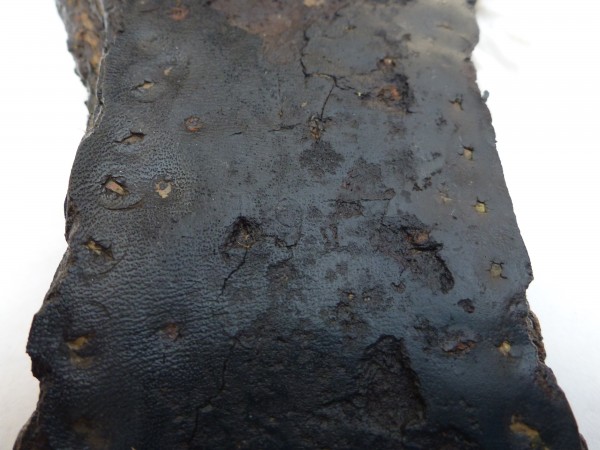 British boot sole with 1917 on the insole _
We also had a large, white with blue fleck enamel kettle. This still had soot on the bottom (from the stove) and lime-scale inside. One of the benefits of doing the conservation work in the Plugstreet 14-18 Experience is we get to meet lots of visitors. Yesterday we spoke with a lovely elderly Belgian lady in her 80’s who remembered that her mother had a similar kettle in white enamel with roses on it.
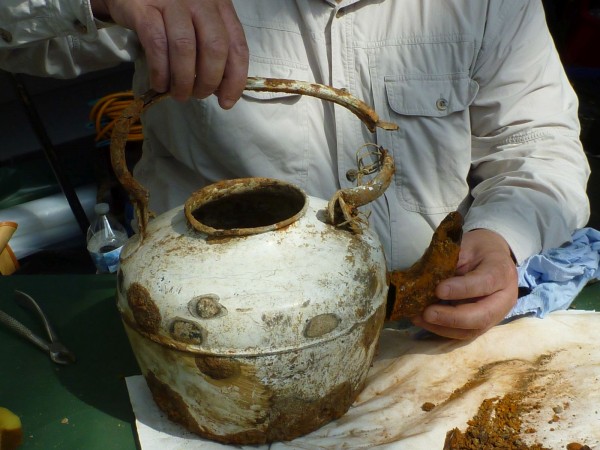 White enamel kettle _
We have also started to get lots of pieces of embossed sheet metalwork no doubt part of some decorative fixture from the chateau.
_
|
|
|
|
|
|
Filed under: A Dig Diary, Archaeology by
Finds Room
Add a Comment »
|
|
Some early finds Wednesday, July 23rd, 2014
|
|
|
|
|
We are now on day 3 of Plugstreet 2014. We have got a wide variety of finds coming out of the trenches at Chateau de la Hutte and Plugstreet Wood._
The Finds Team always get quite excited when we can identify and provenance some of the objects we receive. For example, the bottle fragment below didn’t look much when it came in. After cleaning we could read the words “Royal Warrant”. Some cursory research revealed this is likely an Idris Ginger Beer bottle – a delightfully British find in rural Belgium! Lots of complete bottles of this type have been found on the Somme battlefields.
_
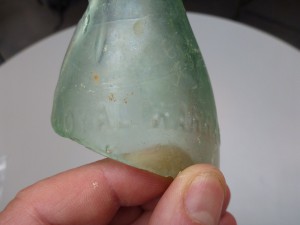 Idris Ginger Beer bottle _
Although most people think of fighting in this part of Belgium being associated with the First World War and especially the Battle of Messines in 1917. However this ground also was fought over during May 1940 when parts of the British Expeditionary Force attempted to delay the German advance and keep the “Dunkirk corridor” open for a bit longer. We were excited to find some German cartridge cases. These were cleaned to reveal the headstamps (markings on the base of the case which indicate such things as date and place of manufacture). In this case we had one brass case round made in Magdeburg in 1936, while others were of copper coated steel made in 1938/39. _
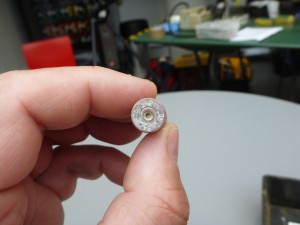 German Mauser round |
|
|
|
|
|
Filed under: A Dig Diary, Archaeology by
Finds Room
Add a Comment »
|
|
Back in Plugstreet Monday, July 21st, 2014
|
|
|
|
|
The team assembled outside the Auberge at 9am today. This year we are investigating two sites behind the front line, one a point marked on the maps from 1917 onwards, the other situated on the highest land in Allied hands prior to the Battle of Messines.
_
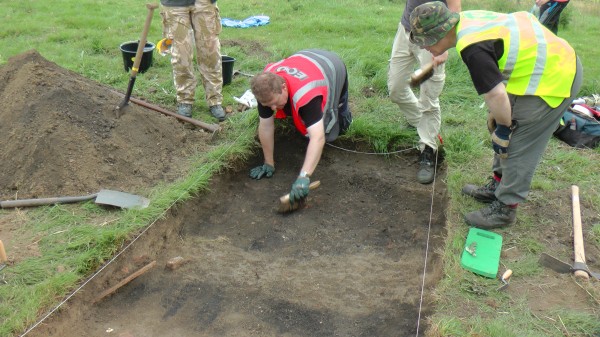
_
On of our two trenches in the grounds of La Hutte Chateau, with a curious spread of cinders and debris from the building.
_
_
The other trench has also revealed a small amount of demolition rubble and evidence of communication wire.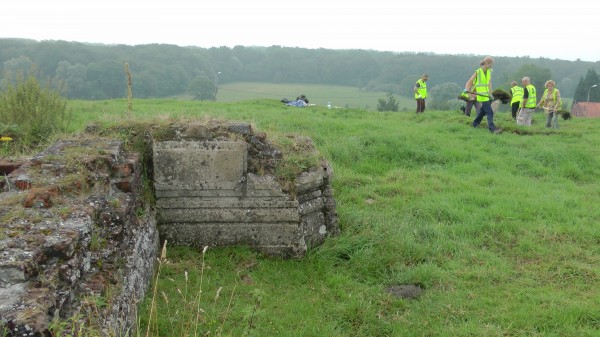
_
In the woods we have opened two trenches, one in search of the light railway, the other in search of the feature on the maps.
_
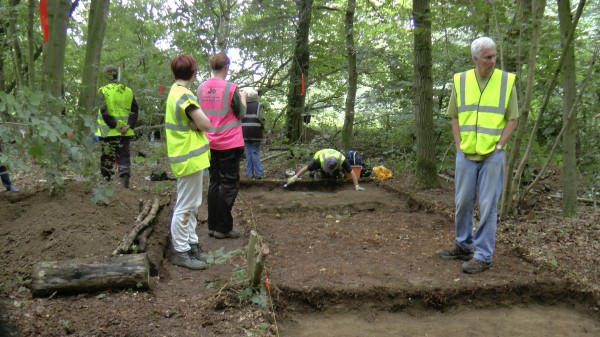
_
|
|
|
|
|
|
Filed under: A Dig Diary by
PlugStreetTeam
1 Comment »
|
|
In preparation for our 2014 excavations Monday, July 14th, 2014
|
|
|
|
|
The team are currently preparing for the 2014 trip to the battlefields. As you can imagine a lot of work goes into researching potential targets for excavation long before we arrive on site, many hours are spent examining maps, documents, war diaries and photographs alongside geophysics results in order to maximize our limited time in the field.
_
As this year sees the centenary of the start of the Great War, team members have been exceptionally busy all year with our own projects and working with other groups to help others learn about their own families and local communities. Already we have seen a large increase in the volume of contributions of stories and photos of those who took part in the Battle of Messines to be listed on our website, every one unique and a great addition to building the bigger picture of events. If your relative was one of the many men involved in the battle, please consider adding their name to our site along with any details you have.
_
If you are looking for help with researching your relative, you may find the The Wartime Memories Project help with research useful, they also have a huge collection of stories from all aspects of the war.
_
We have also recently been sent a copy of the excellent free booklet 1914-1919 As Reported At The Time, which has been produced by Historic Newspapers as a teaching resource. Teachers and education institutions can apply for a copy via the link.
|
|
|
|
|
|
Filed under: A Dig Diary, Archaeology by
PlugStreetTeam
Add a Comment »
|
|
|
|
|
|